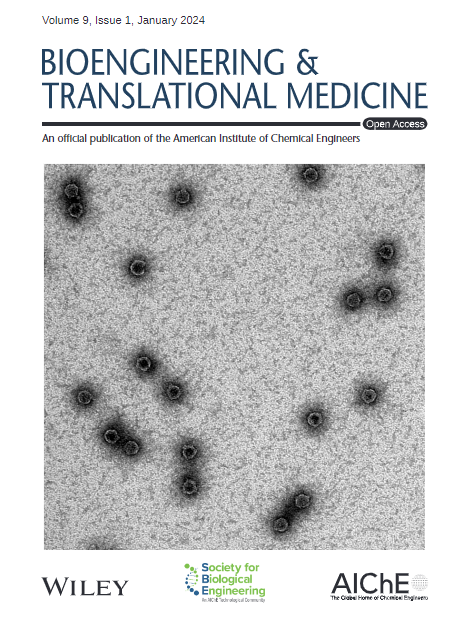通过核苷酸结合寡聚化结构域样受体蛋白3炎性体抑制工程巨噬细胞表型转换:使用抗生素水泥治疗糖尿病足溃疡的翻译方法
IF 5.7
2区 医学
Q1 ENGINEERING, BIOMEDICAL
引用次数: 0
摘要
糖尿病足溃疡(DFUs)是一种使人衰弱的糖尿病并发症,持续的炎症会破坏伤口修复,从而加剧溃疡。本研究探讨了抗生素负载骨水泥(ALBC)在调节NLRP3炎性体激活和巨噬细胞极化以缓解慢性炎症和加速愈合方面的治疗潜力。在高糖条件下,我们使用具有背伤和RAW264.7巨噬细胞的db/db糖尿病小鼠,在体内和体外测试了分级ALBC剂量(高剂量ALBC、低剂量ALBC和中剂量ALBC)。多模式分析——包括细胞因子分析(酶联免疫吸附测定)、巨噬细胞表型分析(流式细胞术/免疫荧光)和分子途径分析(逆转录定量PCR/Western blot)——显示ALBC剂量依赖性地抑制NLRP3炎性体组装,减少IL - 1β/IL - 18分泌,并使巨噬细胞向抗炎M2表型倾斜。NLRP3的药理激活逆转了这些作用,证实了通路的特异性。ALBC处理的伤口表现出加速的再上皮化、胶原沉积和血管生成,与全身炎症减轻相关。至关重要的是,临床DFU样本反映了临床前的发现,在ALBC反应性病例中显示NLRP3下调和M2优势。这些结果表明,ALBC通过沉默NLRP3驱动的炎症和促进促修复性巨噬细胞反应来协调免疫代谢重编程。通过将生物材料工程与免疫调节相结合,本研究提出了一种可翻译的难治性DFU治疗策略,提供了一种结合局部抗生素递送和微环境免疫重置的双作用治疗平台。本文章由计算机程序翻译,如有差异,请以英文原文为准。
Engineering macrophage phenotype switching via nucleotide‐binding oligomerization domain‐like receptor protein 3 inflammasome inhibition: A translational approach using antibiotic cement for diabetic foot ulcers
Diabetic foot ulcers (DFUs), a debilitating complication of diabetes, are exacerbated by persistent inflammation that disrupts wound repair. This study explores the therapeutic potential of antibiotic‐loaded bone cement (ALBC) in modulating NLRP3 inflammasome activation and macrophage polarization to resolve chronic inflammation and accelerate healing. Using db/db diabetic mice with dorsal wounds and RAW264.7 macrophages under high‐glucose conditions, we tested graded ALBC doses (high‐dose ALBC, low‐dose ALBC, and medium‐dose ALBC) both in vivo and in vitro. Multi‐modal analyses—including cytokine profiling (enzyme‐linked immunosorbent assay), macrophage phenotyping (flow cytometry/immunofluorescence), and molecular pathway interrogation (reverse transcription quantitative PCR/Western blot)—revealed that ALBC dose‐dependently suppressed NLRP3 inflammasome assembly, reduced IL‐1β/IL‐18 secretion, and skewed macrophages toward anti‐inflammatory M2 phenotypes. Pharmacological NLRP3 activation reversed these effects, confirming pathway specificity. ALBC‐treated wounds exhibited accelerated re‐epithelialization, collagen deposition, and angiogenesis, correlating with attenuated systemic inflammation. Crucially, clinical DFU samples mirrored preclinical findings, showing NLRP3 downregulation and M2 dominance in ALBC‐responsive cases. These results demonstrate that ALBC orchestrates immunometabolic reprogramming by silencing NLRP3‐driven inflammation and fostering pro‐reparative macrophage responses. By bridging biomaterial engineering with immunomodulation, this work advances a translatable strategy for refractory DFU management, offering a dual‐action therapeutic platform that combines localized antibiotic delivery with microenvironmental immune reset.
求助全文
通过发布文献求助,成功后即可免费获取论文全文。
去求助
来源期刊

Bioengineering & Translational Medicine
Pharmacology, Toxicology and Pharmaceutics-Pharmaceutical Science
CiteScore
8.40
自引率
4.10%
发文量
150
审稿时长
12 weeks
期刊介绍:
Bioengineering & Translational Medicine, an official, peer-reviewed online open-access journal of the American Institute of Chemical Engineers (AIChE) and the Society for Biological Engineering (SBE), focuses on how chemical and biological engineering approaches drive innovative technologies and solutions that impact clinical practice and commercial healthcare products.
 求助内容:
求助内容: 应助结果提醒方式:
应助结果提醒方式:


